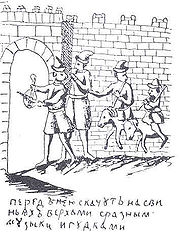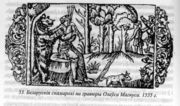
Skomorokh
Encyclopedia


Harlequin
Harlequin or Arlecchino in Italian, Arlequin in French, and Arlequín in Spanish is the most popularly known of the zanni or comic servant characters from the Italian Commedia dell'arte and its descendant, the Harlequinade.-Origins:...
s, i.e. actors, who could also sing, dance, play musical instruments and compose most of the scores for their oral/musical and dramatic performances. The etymology of the word is not completely clear. There are hypotheses that the word is derived from the Greek
Greek language
Greek is an independent branch of the Indo-European family of languages. Native to the southern Balkans, it has the longest documented history of any Indo-European language, spanning 34 centuries of written records. Its writing system has been the Greek alphabet for the majority of its history;...
σκώμμαρχος (cf. σκῶμμα, "joke"); from the Italian
Italian language
Italian is a Romance language spoken mainly in Europe: Italy, Switzerland, San Marino, Vatican City, by minorities in Malta, Monaco, Croatia, Slovenia, France, Libya, Eritrea, and Somalia, and by immigrant communities in the Americas and Australia...
scaramuccia ("joker", cf. English
English language
English is a West Germanic language that arose in the Anglo-Saxon kingdoms of England and spread into what was to become south-east Scotland under the influence of the Anglian medieval kingdom of Northumbria...
scaramouch); from the Arabic
Arabic language
Arabic is a name applied to the descendants of the Classical Arabic language of the 6th century AD, used most prominently in the Quran, the Islamic Holy Book...
masẋara; and many others.
The skomorokhs appeared in Kievan Rus no later than the mid-11th century although fresco
Fresco
Fresco is any of several related mural painting types, executed on plaster on walls or ceilings. The word fresco comes from the Greek word affresca which derives from the Latin word for "fresh". Frescoes first developed in the ancient world and continued to be popular through the Renaissance...
depictions of skomorokh musicians in the Saint Sophia Cathedral in Kiev
Saint Sophia Cathedral in Kiev
Saint Sophia Cathedral in Kiev is an outstanding architectural monument of Kievan Rus'. Today, it is one of the city's best known landmarks and the first Ukrainian patrimony to be inscribed on the World Heritage List along with the Kiev Cave Monastery complex...
which previously were thought to be dated to the 11th century have been recently shown to have been done in 1848.
The Primary chronicle
Primary Chronicle
The Primary Chronicle , Ruthenian Primary Chronicle or Russian Primary Chronicle, is a history of Kievan Rus' from about 850 to 1110, originally compiled in Kiev about 1113.- Three editions :...
data about skomorokhi concurs with the period. The monk chronicler denounced the skomorokhi as devil servants. Furthermore the Orthodox Church often railed against the skomorokhi and other elements of popular culture as being irreverent, detracting from the worship of God, or even downright diabolical. For example Theodosius of Kiev
Theodosius of Kiev
Theodosius of Kiev is an 11th century saint who brought Cenobitic Monasticism to Kievan Rus' and, together with St Anthony of Kiev, founded the Kiev Caves Lavra...
, one of the co-founders of the Caves Monastery in the eleventh century, called the skomorokhi "evils to be shunned by good Christians". Their art was related and addressed to the common people and usually opposed the ruling groups who considered them not just useless but ideologically detrimental and dangerous by both the feudalists and the clergy.
Skomorokhi were persecuted in the years of the Mongol yoke when the church strenuously propagated ascetic living. The skomorokh art reached its peak in the 15th–17th century. Their repertoire included mock songs, dramatic and satirical sketches called glumy (глумы) performed in masks and skomorokh dresses to the sounds of domra
Domra
The domra is a long-necked Russian string instrument of the lute family with a round body and three or four metal strings.-History:In 1896, a student of Vasily Vasilievich Andreyev found a broken instrument in a stable in rural Russia...
, balalaika
Balalaika
The balalaika is a stringed musical instrument popular in Russia, with a characteristic triangular body and three strings.The balalaika family of instruments includes instruments of various sizes, from the highest-pitched to the lowest, the prima balalaika, secunda balalaika, alto balalaika, bass...
, gudok
Gudok
The gudok or hudok is an ancient Eastern Slavic string musical instrument, played with a bow.A gudok usually had three strings, two of them tuned in unison and played as a drone, the third tuned a fifth higher. All three strings were in the same plane at the bridge, so that a bow could make them...
, bagpipes
Bagpipes
Bagpipes are a class of musical instrument, aerophones, using enclosed reeds fed from a constant reservoir of air in the form of a bag. Though the Scottish Great Highland Bagpipe and Irish uilleann pipes have the greatest international visibility, bagpipes of many different types come from...
or buben (a kind of tambourine
Tambourine
The tambourine or marine is a musical instrument of the percussion family consisting of a frame, often of wood or plastic, with pairs of small metal jingles, called "zils". Classically the term tambourine denotes an instrument with a drumhead, though some variants may not have a head at all....
). The appearance of Russian puppet theatre was directly associated with skomorokh performances.
The skomorokhs performed in the streets and city squares engaging with the spectators to draw them into their play. Usually the main character of the skomorokh performance was a fun-loving saucy muzhik (мужик) of comic simplicity. In the 16th–17th century the skomorokhs would sometimes combine their efforts and perform in a vataga (ватага, or big crowd) numbering 70 to 100 people. The skomorokhs were often persecuted by the Russian Orthodox Church
Russian Orthodox Church
The Russian Orthodox Church or, alternatively, the Moscow Patriarchate The ROC is often said to be the largest of the Eastern Orthodox churches in the world; including all the autocephalous churches under its umbrella, its adherents number over 150 million worldwide—about half of the 300 million...
and civilian authorities.
In 1648 and 1657, Tsar
Tsar
Tsar is a title used to designate certain European Slavic monarchs or supreme rulers. As a system of government in the Tsardom of Russia and Russian Empire, it is known as Tsarist autocracy, or Tsarism...
Alexei Mikhailovich
Alexis I of Russia
Aleksey Mikhailovich Romanov was the Tsar of Russia during some of the most eventful decades of the mid-17th century...
issued ukase
Ukase
A ukase , in Imperial Russia, was a proclamation of the tsar, government, or a religious leader that had the force of law...
s banning the skomorokh art as blasphemous but the actors would still occasionally perform during popular celebrations. In the 18th century the skomorokh art gradually died away; passing on some of its traditions to the balagans (балаган) and rayok
Rayok
Rayok literally means "small paradise" in Russian. By extension it came to mean a fairground peep show, as "The Fall" was one of the most popular topics for these. The show itself was performed with the help of a box with pictures viewed through magnifying lenses...
s (раёк).

